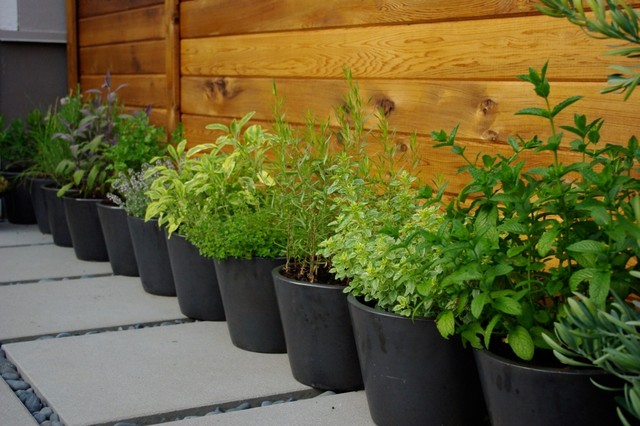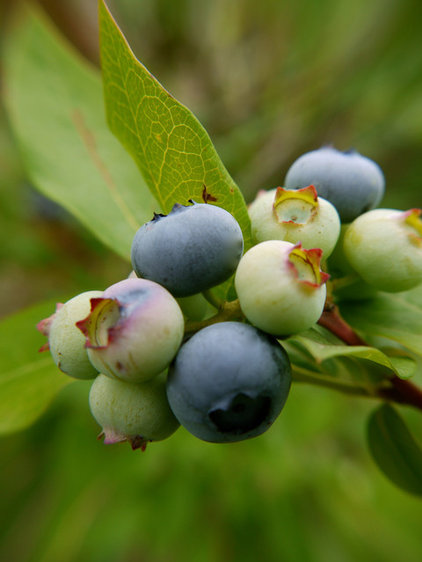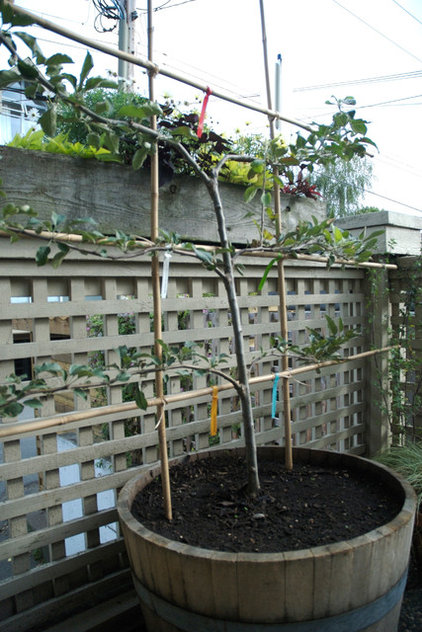6 Ways to Grow Edibles in Small Places
The first step is to take a good look at your space and assess what resources you have available. Light and water access are the two biggest requirements of a food garden. Most food crops require a large amount of sunlight, something that small spaces sometimes lack. However, there are some crops that thrive in lower-light conditions. Regular water access is also key to healthy crops and should be considered when you're configuring a food garden. As long as you can access water and provide proper drainage, a happy food garden is in your future!
Let's look at some options for growing edibles in small spaces.
|
by Aloe Designs
»
|
|
1. Container gardening. Whether
they're pots of herbs or troughs full of greens and root crops,
containers work well to maximize small spaces. Prefab containers come in
numerous shapes, sizes and materials.
It’s worth noting that not all containers are created equal. If you live in an area that has cold winter weather, it’s important to select containers that can deal with fluctuations in temperature. Steer clear of terra-cotta, as it can crack and dry out roots; look for the many emerging polycarbonate and fiberglass options instead. They will cost you more initially, but they are built to last, and you won’t have any nasty surprises in the winter. |
|
by Aloe Designs
»
|
|
2. Raised vegetable beds. If
you have a bit more room, a raised vegetable bed is a great way to grow
crops. Aside from having the functional benefit of providing easier
access to the plants, raised beds improve the drainage and aeration of
the soil and allow the bed to warm more quickly in the spring, so you
can plant earlier. Raised beds can be built out of anything, as long as
the material doesn’t contain chemicals that can leach into the soil. Use
cedar or hardwood lumber instead of a pressure-treated material for a
long-lasting, chemical-free bed.
|
|
|
|
3. Square-foot gardening. This
simple method of organizing crops works best in a raised bed and will
maximize the surface area of your garden to produce large yields of
crops. It entails dividing the soil area into 1-square-foot cells, using
twine, wood or wire affixed in a grid format to the top of the raised
bed.
Different crops of vegetables can then be planted in each cell. When a crop is harvested, a different crop is replanted in the cell. This rotation of crops ensures that nutrients aren’t exhausted from the soil, and plants benefit from companion plantings that promote healthy growth and pest resistance. See more about companion plants |
Note: Blueberries require several different varieties present to produce fruit through cross-pollination.
See the Houzz guide to growing blueberries
|
by Aloe Designs
»
|
|
5. Grow potatoes in sacks. A great way to grow potatoes
is in old coffee sacks. Most coffee roasters will be happy to part with
some sacks for you to use for this purpose, and it’s easy to set up a
row of potato sacks that will provide you with a pantry full of spuds.
Start with a sack rolled down two-thirds of the way and fill the bottom
with soil. Place seed potatoes inside and cover them with soil.
As the potato plants grow, roll up the sides of the sack until the sack is fully upright. When the potatoes are ready to harvest (the leaves have turned yellow), lift the sides of the sack, and the potatoes and soil will fall out the bottom. The bottom rots out of the sack soon after initial planting, so make sure not to move the sack before you’re ready to harvest. How to grow potatoes |
Using the age-old technique of espaliering trees — in which branches are trained to a structure (to provide support when the trees are laden down with fruit) and tips are pruned to maintain a compact size — it is possible to have a flourishing fruit orchard on your patio. Make sure that the container you choose is large enough to be topped with fresh compost every year (fruit trees are big feeders, so you must provide fertile soil to aid fruit production) and that you locate it in a site where there is adequate sun exposure.





